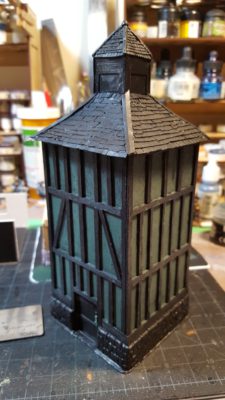When we last saw the dovecote, the halftimber detailing on the walls was done, the roof was just started, and it lacked paint.
Here’s the current state of the beast!

The roof got cardboard tiles to look like slate on both the main roof and the top of the tower. The capping along the ridges on the main roof is strips of light card, while for the tower roof I used greenstuff putty for the ridge caps and the little finial decoration right at the peak.
I also used a bit of greenstuff to add a ring handle to the door, and some details to the hinges.
The whole thing has been primed black, and then the wall panels between the timbers got a coat of GW Liquid Greenstuff to add some extra texture to those areas.
I’ve also started work on a large farmhouse, two stories with a thatch roof planned for it. More photos of that soon, it’s coming along nicely and I suspect I’ll paint both buildings at the same time.
I’ve had people ask about plans for these buildings. I rarely make formal plans for buildings in a way that would be useful to other people, to be honest! For the dovecote I started with the article in WS&S #87 and tweaked things slightly; the farmhouse is entirely out of my head, starting with a basic idea of how large I wanted the building to be (about 5″ by 3″, as it happens) and the basic features I wanted. I have spent some time looking at photos and sketches of the real thing; the post I wrote a few years ago on half-timber architecture in the Internet Archive is still useful, as is Google Image Search for terms like “17th Century English farmhouse” and similar. A lot of buildings like this, especially rural or village buildings, could be pretty wonky and random, so it’s kind of hard to get things wrong! If in doubt, just chuck a coat of plaster over it, like real builders have been known to do!
